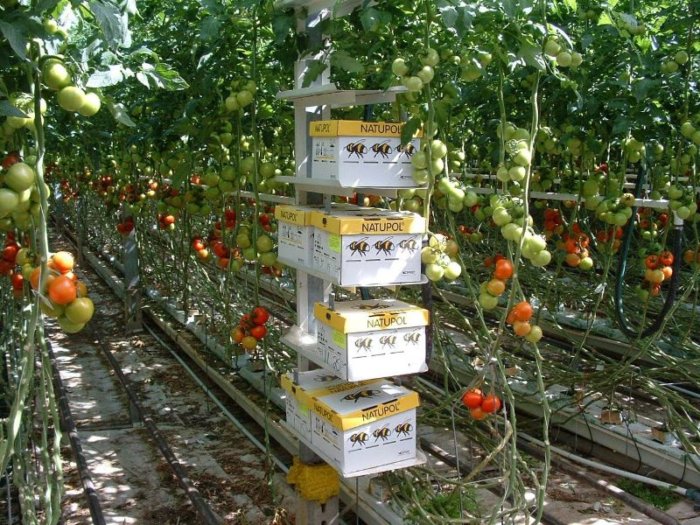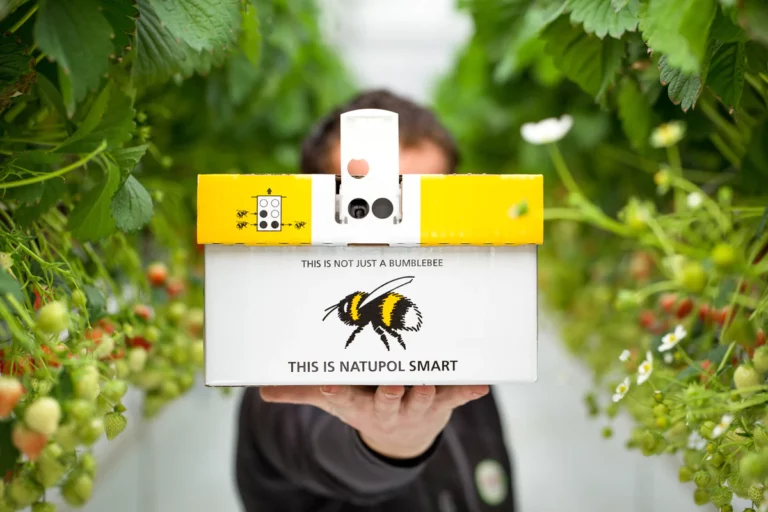As I stepped into the serene embrace of my greenhouse, surrounded by flourishing flora, an intriguing thought buzzed in my mind: Can I bees in a greenhouse?
The idea of cultivating a thriving garden and nurturing a vibrant bee colony beneath the transparent roof was a concept both novel and enticing. It ignited a journey of exploration, and today, I invite you to join me on this extraordinary beekeeping odyssey.
Yes, you can keep honey bees in a greenhouse, especially since they are great pollinators. However, your greenhouse has to provide the right conditions and allow the bees to come and go as they please. You can also consider bumblebees as a more low-maintenance solution.
In this guide, we embark on a journey that fuses the delicate world of bees with the controlled environment of a greenhouse. So, let’s don our beekeeping suits and unveil the secrets of keeping bees in a greenhouse.
How to Set up a Beehive in a Greenhouse?

Optimize the Location:
For an optimal hive location, orient it to face the south, while ensuring it’s elevated to prevent dampness. Constructing a cement pad beneath the hive platform can prevent mud buildup and water retention, ensuring a comfortable environment for your bees.
Welcome Your Bees to Their New Abode:
Providing your bees with a favorable start is key. Placing them in a new hive during spring, when blooming flowers abound, ensures a natural food supply. This step should be relatively straightforward once you have acquired the bees and set up the hive.
Nourish Your Bees:
Starting with a new colony requires diligent care. You’ll need to tend to the queen and her brood by providing them with nourishment. Create a simple nectar substitute by mixing equal parts of granulated sugar and water, which can be fed to the bees.
Maintain Vigilance Over Your Hive:
For those new to beekeeping, realize that observation is paramount. Regularly inspect the hive for cleanliness, ensuring it is free of bee waste and debris, with no unwelcome ants in sight. Open the hive periodically to examine the frames for eggs and larvae at various developmental stages, an indicator of a thriving queen.
However, avoid excessive intrusion; frequent disruptions to the hive can distress the bees unnecessarily.
Guard Against Diseases and Pests:
Vigilance is crucial to protect your hive from common threats such as Varroa mites, small hive beetles, wax moths, and diseases like American and European foulbrood. Swiftly address these issues to prevent them from causing harm or potentially decimating your hive.
Observe Your Hive Flourish:
Start with a single body-brood box as a deep hive and expand as your bee population grows. Begin by adding a second brood box, and when it becomes congested, consider using a queen excluder if necessary. Top it off with a honey super, where the precious honey produced by your bees will be stored.
Ventilation:
Greenhouses can get hot and humid, especially during the summer months. Bees need good ventilation to regulate the temperature and humidity inside the greenhouse. Ensure that your greenhouse has proper ventilation systems in place to prevent overheating and excess moisture.
Regulations:
Check local regulations and permits related to beekeeping in greenhouses. Some areas may have specific rules governing beekeeping activities.
What are the Pros and Cons of Having Honey Bees in the Greenhouse?
PROS:
- Enhanced Fruit Quality: Research has substantiated that plants benefiting from bee pollination tend to yield fruits rich in essential vitamins and nutrients. This not only elevates the nutritional value but also augments overall product yield, contributing to better returns.
- Reduced Labor Intensity: Greenhouse pollination traditionally relies on manual labor, which can be both labor-intensive and costly. By harnessing the power of bees, you can significantly reduce labor costs while benefiting from their remarkable efficiency and speed in pollinating your crops.
- Eco-Friendly Approach: Embracing bee pollination promotes an eco-friendly environment within your greenhouse. The necessity to avoid pesticides, which can harm these pollinators, ensures that your produce remains free from harmful chemicals, resulting in healthier and more sustainable products.
CONS:
- Suboptimal Choice for Some Crops: It’s imperative to recognize that honey bees may not be the optimal choice for all greenhouse crops. Certain plant varieties require specialized pollination methods, such as vibration, which honey bees cannot provide. Therefore, a tailored approach is essential.
- Aggressive Behavior: Honey bees exhibit aggression when collecting nectar for their honey production. This can pose challenges when interacting with human workers within the greenhouse. The potential for conflicts between bees and workers should be carefully considered.
- Preference for Bumblebees: While honey bees can be effective pollinators, bumblebees often prove to be superior choices for many greenhouse applications. Understanding the specific requirements of your crops and the advantages of bumblebees over honey bees is essential to making an informed decision.
Why Bumblebees May Be a Better Choice Than Honey Bees?
Enhanced Visual Acuity: Bumblebees possess superior sight, a crucial asset when navigating the often perplexing illumination conditions within greenhouses. Their heightened visual orientation facilitates efficient plant location, ensuring comprehensive pollination.
Robust Resilience: Unlike honey bees, which are sensitive to fluctuating environmental conditions, bumblebees exhibit remarkable adaptability. They thrive in a broader spectrum of temperatures and adverse conditions, making them a reliable choice, particularly during harsh winter periods.
Pollen Predilection: Bumblebees have a distinct affinity for pollen. Their diligent pursuit of pollen-rich blooms brings them into close proximity to the reproductive organs of plants, increasing the likelihood of effective pollination—a crucial factor for crop success.
Gentle Disposition: Bumblebees are notably less aggressive than their honey bee counterparts. They can seamlessly coexist with human workers in the greenhouse environment without posing a significant threat. Incidents of stinging are rare, provided they are not provoked.
Plant Compatibility: Several plant varieties align more favorably with bumblebee pollination. Crops such as tomatoes, berries, peppers, carrots, cucumbers, and cabbage, among others, tend to benefit significantly from the precision and diligence of bumblebee pollinators.
Efficient but Short-lived: It’s important to acknowledge that while bumblebees offer efficiency, their lifespan is relatively shorter, typically spanning four to eight weeks. This necessitates periodic replacement to sustain pollination efforts, contingent upon your production needs.
Honey Bee Longevity: In contrast, honey bees, particularly the queen, can live up to two years and continually generate new bees. This longevity makes honey bee colonies a more sustainable option in the long term.
In summary, selecting bumblebees as your greenhouse pollinators presents a compelling array of benefits, including improved visual acuity, adaptability to diverse conditions, a penchant for pollen, amiable behavior, and plant-specific suitability.
While their shorter lifespan necessitates periodic replacement, the advantages they offer in terms of precise pollination can significantly enhance crop yields and quality.
However, for a sustainable, long-term solution, honey bee colonies, with their extended lifespan and continuous bee production, may also warrant consideration, depending on your specific greenhouse goals.
How do I keep my greenhouse constantly pollinated using bumblebee hives?

To ensure a continuous and robust pollination process within your greenhouse, a strategic approach is paramount. Bumblebee hives, with their limited lifespan of four to twelve weeks, necessitate a well-structured hive management system. To achieve uninterrupted pollination, consider acquiring multiple hives and implementing a staggered addition approach, introducing new hives every two weeks.
Also, the number of hives required depends on the specific characteristics of your greenhouse, such as its size and the diversity of crops you cultivate. Smaller greenhouses naturally demand fewer hives, while a greater abundance of flowering plants necessitates a proportional increase in the bee population.
Moreover, the initial establishment of pollination is uncomplicated. Acquire the necessary bumblebee colonies and allow them a period of acclimatization within their containers. Once they have adapted to their new environment, the hives can be opened, allowing the bees to commence their vital work.
In addition, these industrious bees will soon take to the skies, diligently pollinating your plants. Remarkably, the process closely mirrors that of honeybees, albeit with the advantage of less frequent hive replacements. This approach guarantees a consistent and efficient pollination cycle, maintaining the health and productivity of your greenhouse crops.
For further insights and guidance on greenhouse pollination strategies, explore this comprehensive resource.
FAQ:
1. Do bees produce honey in the greenhouse?
– Yes, Bees can produce honey in a greenhouse if they have access to nectar-rich flowers inside, but it’s more common to use bees for pollination in greenhouses rather than honey production.
2. How do you use bees in a greenhouse?
– Bees are used in greenhouses as pollinators to help fertilize plants. They enhance fruit and vegetable production by transferring pollen from male to female flowers.
3.How do I keep bees from getting stuck in my greenhouse?
To prevent bees from getting trapped, provide a clear exit path, use screen doors or windows, and avoid the use of strong scents or pheromones that might attract them but not provide a way out.
4.Will bees pollinate in a greenhouse?
-Yes, bees can pollinate plants in a greenhouse. However, in some cases, it may require introducing bees manually or using bumblebees specifically bred for greenhouse pollination, as the controlled environment can limit natural bee access.
Final words:
In conclusion, I’ve discovered that it’s entirely possible to keep bees in a greenhouse, and it’s a fascinating endeavor. Whether you choose honey bees or bumblebees, the key is to create a comfortable and well-maintained environment.
Furthermore, make sure your hive is in the right spot, time your bee introduction well, and keep an eye on their health and the hive’s cleanliness. It’s important to protect your bees from common threats and provide proper ventilation in the greenhouse.
Plus, always check local rules and permits to stay in line with regulations. Overall, beekeeping in a greenhouse is not only doable but can be a fulfilling way to support pollination, enjoy the benefits of fresh honey, and contribute positively to the ecosystem.

